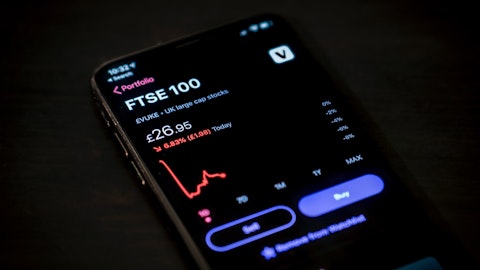But at what point do you kind of say that, hey, that’s taking too long or maybe that’s just structurally not coming back as much as you think kind of given the job cuts there. I was wondering, do you envision a point where you’re structurally thinking of moving away from West Coast corporate as much exposure as you had and moving more towards a leader traveler?Andrew Harrison That’s actually a really good question, Ravi. I think where we are, for now, is that the close-in volumes aren’t there. And so we’re going to be biasing towards building the volumes outside of the typical business window. Actually, right now, leisure revenues are up about 130% versus 2019, very, very strong. And so we’re going to continue to capitalize on that and watch that.
And I think on the network side, some of the hub to hub heavy traditional business traffic markets, we’re going to sort of trim back and maybe put that capacity elsewhere. So again, we’re watching it. But I think that’s going to be a big question as we move forward through this year.Ravi Shanker Got it. That’s helpful. And maybe as a follow-up. Kind of given your West Coast alliance and get a part of oneworld, how do we think about China reopening as a potential tailwind for you guys over the next 12 months? Kind of how do you size the multiplier effect of domestic travel once you have people coming in through the West Coast hubs?Nathaniel Pieper Ravi, it’s Nat Pieper. Great question on China. And I can’t speak specifically to that as we’re kind of watching that with all of our Alliance Partners.
What I can say is that we’re really optimistic and bullish with the oneworld feed and linking our West Coast network to our partners, whether it’s nonstop flights into Seattle, Japan Airlines to Tokyo, Finair to Helsinki and then Los Angeles with Iberia. We’re really seeing a lot of pickup and a lot of incremental revenue that’s getting there. So as China opens over time, we’d expect to participate in that through our partners.Operator We’ll move next to Andrew Didora with Bank of America.Andrew Didora Andrew, just can you talk to how recovered your California market is right now? How do you think about the build up here? And we’ve actually heard anecdotally over the last few days from several folks just — and seeing transcon fares pretty weak.
What kind of dynamic do you think is going on there that from your seat?Andrew Harrison Yes. I think we talk in macro levels about our growth and getting back flat with ’19. The reality is Seattle is actually healthily above 2019. And the rest of the network and specifically California is still below 2019. And so in some respects, I think that’s the right place to be. I think on a year-over-year basis, we’ve actually, in our network, at least being very happy with our unit revenue performance in the California market because we are building ourselves back to a stronger place. And so at the highest level, your comments are actually absolutely true. I think for us internally, we feel good that our California network is actually improving.Andrew Didora Got it.
And then thoughts on transcon?Andrew Harrison California transCon?Andrew Didora Yes.Andrew Harrison Yes. Again, I think especially with our partnership with American and part of oneworld, we’ve got code on these flights, especially out of the Bay Area that’s really helping. And I think we’ll see what happens this summer, although it’s not specifically West Coast, but I think the general New York areas, some of the slots are being pulled down a little bit. But again, I think we’re in a better position than we were certainly last year as it relates to the transcon markets.Andrew Didora Got it. Understood. And then, Shane, what would have to happen for you to consider buying back more stock than just for dilution purposes?Shane Tackett Andrew, I might just add one thing.
I think your sort of implication of the question is California is somewhat weaker in terms of recovery than a lot of the rest of the country. And I think that’s generally true. We’ve done a good job putting the right supply in there, but it’s all upside for us. And I think we’re feeling good because we’ve got a chance to still be the industry’s top margin producer and further upside when California does recover. It’s the sixth largest economy in the world. It’s going to come back…Andrew Didora I wasn’t saying that it was unexpectedly weak. I was just curious where it was in the recovery?Shane Tackett Got you. No, I appreciate that. Yes, I think we’re — I think if we continue to trade at prices that we believe are a really good value, which is what we believe about our stock price today, we’ll have a bias to do more than just dilution throughout the year.
So we’ll continue to talk about that internally and with our Board. But I think if prices are where they are today, we’ll probably be more aggressive in the second quarter.Operator Your next question will come from Catherine O’Brien with Goldman Sachs.Catherine O’Brien So maybe just one more on the revenue. Your guidance is implying a reacceleration in RASM in 2Q from 1Q on a versus ’19 basis that helps us for seasonality there. Can you just walk us through what drove the deceleration from year-end into 1Q and what you’re seeing today that gives you confidence in a better 2Q? Is that just higher leisure mix? Or is there anything else driving that improvement?Andrew Harrison Catie, just to touch on Q2 first. We’re actually — we have 63% of the second quarter’s revenues in the books right now.
And I think as I look forward, looking at what we’ve been booking in the last few weeks, both on the yield side and the traffic side, it’s sitting very nicely in our guide. I think from Q4 to Q1, obviously, growth in the first quarter was very significant at 14%. And also, obviously, in what is our weakest quarter being January and February. I think as it relates to January and February, I do think that — and this is on me that we — had we known differently, we probably would have structured and shaped the network a little differently in January and February. And of course, we had some very difficult weather in issues there as well that didn’t help. But — that’s really a big part of the deceleration. But again, as you can see in the graphs, we’re back on up.
We’re accelerating back into March, April, May and June, and I think we’re on a good trajectory.Catherine O’Brien Great. And then maybe one for Shane. So based on your commentary on two half capacity growth and then your comments on being considerate on completion, it sounds like there’s a decent chance you’re going to come in at the higher end of capacity guide. Should that inform our view on how CASM ultimately comes in? Or there offsets that higher capacity where we shouldn’t assume coming in at the higher end of the capacity moves us towards the better end of the down 1 to 3 similar to what we just saw in the first quarter?Shane Tackett And I tried to address this a bit in my script. We were at the high end in Q1 of capacity. We have built conservatism into the capacity guide.
We certainly have more planes and more resources that we could fly harder if we wanted to put more capacity into the system. We’re going to continue to prioritize operational reliability and stability, and we’re going to watch the economy closely. So I think I said in the script that if we continue to complete flights at a high level, we could easily be at the high end of that range. And I think that’s an absolute true statement, and that’s kind of where we would expect to be at this point. I don’t think we should infer too much in terms of a change in our posture on unit costs. Our goal long term would be to be on the high end of the capacity range and the low end of the CASMex range. That’s where we want to get back to. We didn’t do that in Q1.
I think we’ll get there. It’s just a matter of rebuilding this muscle we need stability in the operation, which we now have. We need to lap some of the headwinds that we’ve got, which we’re going to do. And I don’t think we’ve forgotten how to work the cost muscle. We just need some time to go do it. And that’s what we’re going to focus on this year. And by the end of the year, I think we’ll be in a position to outperform capacity and be on the better end of our CASM guide as well.Operator Your next question comes from Duane Pfennigwerth with Evercore ISI.Duane Pfennigwerth Just on the technology corporate recovery status one we’ve been looking for, for a while. I think you said 50% to 60%. Is that a revenue or a volume comment? And maybe you could just put it in context, was it at a higher level than that at any point last year?
In other words, are you seeing any incremental weakness in tech business travel? Or is it kind of bouncing along the bottom where it has been for some time? .Andrew Harrison It’s Andrew. That’s a volume metric that I just gave you. And there are some technology companies that are way worse than that and some that are actually way better than that. I think just going off memory, I think back in the third quarter of ’22, I think we saw a resurgence a little bit of tech. And then we started to see it collapsed by the back end of the year again. And just — it just really has not changed. And my personal view is that literally, this is driven by the CFOs and a constraint on travel and budgets. And until that gets released, I don’t think we’re going to see an improvement.Benito Minicucci It’s Ben.
Just on that, just being here on the West Coast and watching some of these big tech companies, mandate, return to office, new fiscal budgets coming. It’s not in our forecast, but I think we just see a lot of upside going forward in the future. I think we’re out of the trough, to answer your question, and we’re hopeful that it gets better as these tech companies recover and get stable and then move forward with their business.Duane Pfennigwerth Great. And then — I appreciate that. And then just on revenue management generally and the trade-off between loads and yields any different approach going forward than maybe the one that you entered the March quarter with? And could you just contrast that approach right here and now versus how you thought about the world in 2019?Andrew Harrison Yes.





